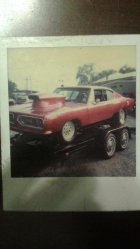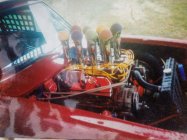urbanrifleman
Site $$ Sponsor
Are you saying heavier valve spring retainers cured the valve float?The head rules for NHRA Stock Eliminator are pretty strict. The heads have to be what came on the production engine or an NHRA approved replacement. These are the G.M. Performance #401 casting heads, which NHRA accepts as a replacement for the rectangular port iron heads. They are better in some respects and worse in others. They do get 80 lbs off the nose of the car, which is significant as a 9" tire is all that's allowed. Valve size has to remain stock, no porting, combustion chambers and ports have to hold the stock volume in cc's. Intake and carb have to be stock production stuff or an NHRA approved replacement for the engine you're working with. The cam also have to have the factory lift for the engine. In the case of this 396-375, it's .520 intake and exhaust. The lifters have be the style that came with the engine...flat tappets on this one. Needless to say, the phasing of the lobes is where lots of gains come from. And lots of pain, too. The lobes on these are incredibly aggressive and managing the lifters and stabilizing the valve train is very, very important not only to keep from hurting stuff but to make power in the upper rpm area.
Our camshaft work didn't advance the power...in fact, it hurt it by more than it should have. This led us to look at some other areas that may have been limiting the power more than we realized, even before the cam change. Some new pieces will be here today and we'll go back to the beginning, get a new baseline and go from there.
That's the nature of dyno work with these severely rules restricted engines. Often, a loss can lead you to explore areas that end up giving you a gain. It's a cycle you repeat over and over to get these engines to make the impressive power they do.
Good shootin'-Al
Butch, it was the spring material itself that cured it. -AlAre you saying heavier valve spring retainers cured the valve float?
Back in the day at Roush working on the road race IMSA and TA cars Jack did not like the 10/30 or 20/50 Motorcraft oils. So he made is own... mixed them together. and yes you could see the difference on the Dyno.Alex...yep. Same oil but just synthetic versus dinosaur oil. These big block Chevies like right at .003 for rod and main clearance and .0032 won't kill you. Most guys are using the 5-20 oils but this builder prefers the 10-30 for the DLC coating on the tool steel lifters. The ring packages in these are very sophisticated with a Napier style second ring to take a bit of load off the oil ring. That lets the oil ring tension get pulled back. On this engine, it only takes 6 lbs/ft of torque to turn the rotating assy. (short block).
On pressure, there's more to be gained in this engine. For example, on my 327 Stocker engine, we modified the oil pump to internally bypass the excess oil volume. We brought the pressure down from 50 at 7,000 to 30 at 7,000 and 'found' 7 hp.
Alex, I can remember when I got that first first set of Air Flow Research heads in the mid ‘70’s. We had been running the big square port heads that had been ported by Crane. They were pretty darned good by the standards of the day.Im a carb guy myself. Never got along well with the quadrajet, but Holleys made sense to me and were easy to tune. Always ran my best times with a Holley. Al would know better than me, but in an engine I look at heads like barrels. Thats the last place to save $$$. Lots of powder in the heads. You can actually do a decent job porting yourself. If you can find a local shop that will flow test or at least guide you. You just need to get one port right then you can duplicate it in the others. Those ports and the cam design in my opinion were the most important things.





My first decent heads were double humps/camel backs I had about 40 hours into. 462 casting numbers if I remember. Low 12s in a very low budget build in a heavy 1980 Camaro. I eventually ponied up for some Brodix heads on a 400 sbc in a malibu. Got to the low 10s in the mid 130s. Should have got in the 9s but the car twisted so bad. 60 ft was bad. Figured out it was gonna take real money and sold it all.Alex, I can remember when I got that first first set of Air Flow Research heads in the mid ‘70’s. We had been running the big square port heads that had been ported by Crane. They were pretty darned good by the standards of the day.
the AFR heads were awhile new game. They were severely angle milled, had the exhaust ports raised and ”D” ported, and had intakes that were a work of art.
The severe angle milling allowed us to run a lot less dome on the piston and still maintain the 13 to 1 compression in the 399 inch big block. The heads flowed so much better that we had to add 10% more overdrive in the V-Drive ans a full 2/2 inch to the pitch in the Prop.
I can’t say exactly how much horsepower we gained with just the heads,(and their recommended cam profile), but looking back, I would venture 75 to 100.
years later, when I had the 540 that is in my Malibu built, I decided on Air Flow Research. Since on the street engine on pump gas is pretty much limited to 10 to 1 compression, you make your power with great heads matched with the correct cam profile……..and of course, cubic inches.
Thanks Al, asking for a buddy.Butch, it's a Super Flo 902. Bob has made some tweaks to the servo for the water brake to get it to repeat like this....this is where art and science come into play. The throttle input from the operator is also crucial. You can change things just by how the throttle is opened against the brake and how it stabilizes before the program runs and takes it to the rpm limit you've set.
The Pro Stock teams have dynos that can repeat to 1.5 hp at over 1,300 hp...pretty impressive. Some have inertia dynos that will simulate the engine making a pass.
Thanks Al, I've passed this on to my good friend.Butch, here's a good example of an inertia dyno and repeatability and accuracy.


What’s the design approach today regarding piston skirts… short or long?An update on the 396-375 Stocker engine. Crunching the numbers, the feeling is there might be 3-4 h.p. in a different ring package and hone profile. Based on that, it's apart and we're proceeding down that path. Once it's back together, we'll go back to the dyno and verify the changes.

